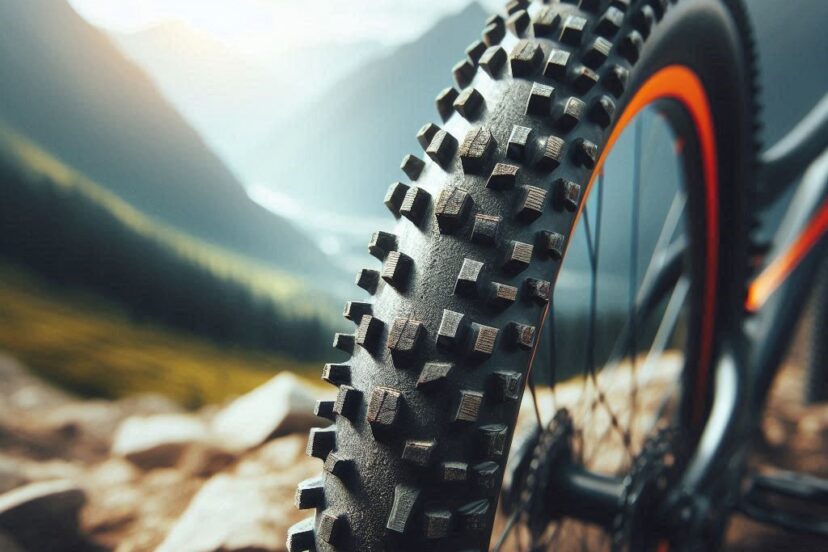Mountain Bike Tires: Essential for Every Trail Adventure
*We may earn a commission for purchases made using our links. Please see our disclosure to learn more.
Mountain Bike Tires: Essential Tips for Choosing the Right Tread
Mountain biking is an exciting sport that requires durable and efficient equipment. One critical part of this is the tires. They are designed to handle diverse terrains, from rocky paths to muddy trails. Mountain bike tires provide better traction and stability, enhancing your ride’s safety and enjoyment.
When choosing mountain bike tires, it’s essential to consider a few key factors. Tire width affects grip and control, while tread patterns determine how well the tire handles different surfaces. Also, some tires have thicker walls for extra durability, which can be beneficial on rougher trails.
I spent many hours riding and comparing various mountain bike tires to find out which ones offer the best performance and reliability.
Top Mountain Bike Tires
I’ve compiled a list of the best mountain bike tires for various terrain and conditions. These picks will help you find the right tire for your next adventure on the trails.
Hycline 2-Pack Mountain Bike Tires Set
A great choice for upgrading older mountain bikes due to their ease of installation and performance.
Pros
- Quick and simple installation with provided tire levers
- Good traction on various surfaces
- Includes replacement tubes
Cons
- Entry-level performance
- Needs careful inflation to avoid popping
- Comes folded, requiring proper arrangement before use
I tried the Hycline 2-Pack Mountain Bike Tires on my older bike, and mounting them was smooth thanks to the tire levers included in the package. They fit snugly and once inflated to the appropriate PSI, performed well on different terrain.
The aggressive tread design provided solid grip on both muddy and gravel paths. I felt confident riding through some tough spots without worrying about slipping or losing control. The included inner tubes were a bonus, reducing vibrations and giving a comfortable ride on rough surfaces.
Despite the low cost, the tires didn’t feel cheap. They seem durable enough for regular use. Just make sure to flatten out the folded steel rim correctly during installation to avoid any issues.
WheelO Mountain Bike Tire Set
These tires are a solid budget option for everyday mountain biking.
Pros
- Durable and resistant to wear and punctures
- Comes with useful extra tools and parts
- Foldable for easy storage and transport
Cons
- Might not handle extreme conditions well
- Some users reported missing parts
- Takes time to unfold and install
I recently used the WheelO mountain bike tire set and found it to be a great fit for regular trails. The tires felt very sturdy on rocky and loose surfaces, thanks to the high-wall tread design. I had no issues with grip or traction.
In the package, you get more than just the tires. It includes bike tubes, tire levers, and rim strips. These extras made the installation process smoother. The foldable design was especially nice for transport; I could easily fit them into my bag without any fuss.
One downside is that these tires may not stand up to very rough terrains or extreme rides. They are best suited for casual biking and daily commutes. There were also a couple of reports of missing tubes in customer reviews, so it’s something to check for when you get your package.
VESPETON Fat Bike Tire 26×4.0″
This tire is a solid choice for those needing stability and grip for various challenging terrains.
Pros
- Excellent stability
- Superior puncture protection
- Strong grip on varied surfaces
Cons
- Can feel bulky
- Takes time to flatten after unpacking
- Initial plastic-like feel
I recently tried the VESPETON Fat Bike Tire on my mountain bike, and the stability it offers was impressive. The 4-inch wide design provided a smooth and balanced ride even on rocky trails. Additionally, the 60 TPI construction really helped with puncture resistance, making my rides worry-free.
In terms of performance, the tread pattern offered excellent grip, whether I was tackling muddy trails or snow-covered paths. The tire consistently provided a secure feel, which boosted my confidence while riding over diverse terrains.
The only minor drawback was that the tire took a bit to flatten out after unboxing, and at first, it had a slightly plastic feel. However, once I started using it, these issues quickly vanished. Overall the VESPETON Fat Bike Tire is a reliable companion for any mountain biking adventure. Trusted it for its performance and convenience.
MOHEGIA Fat Bike Tire
This tire offers great performance for all-terrain riding.
Pros
- Exceptional traction on various surfaces
- Sturdy rubber material resists punctures
- Easy to fold and carry
Cons
- Tread may wear out faster for daily users
- Not as firm as other tires
- Bead might not stay on rim if overinflated
Installing the MOHEGIA Fat Bike Tire on my bike was easy. The aggressive tread pattern provided excellent grip, even on loose dirt and sand. I felt confident navigating sharp turns and rough terrain.
The tire’s wide volume offered stability and control, reducing drag while riding. I appreciated the sturdy rubber material, which handled rocky paths without puncturing. While the foldable carbon steel bead made transport simple, I did notice it requires some care during inflation to avoid bead slippage.
The tire’s performance was impressive overall, particularly for the price. It may wear out more quickly with daily use, but for weekend adventures on various terrains, it’s a solid choice. If you’re looking for reliable traction and durability, this tire might be the one to consider.
VESPETON Bike Tires Pair
These tires are reliable and worth the investment for any mountain biking enthusiast.
Pros
- Excellent grip
- Easy to carry
- Enhanced comfort
Cons
- No inner tube included
- Limited to certain sizes
- Higher price point
I’ve recently tried the VESPETON Bike Tires, and they definitely deliver on both performance and durability. These tires feature a deep tread texture, which really improves traction on all sorts of terrain. From rocky paths to muddy trails, the grip is phenomenal, making rough rides feel safer and more controlled.
One of my favorite aspects is how easy they are to carry. Made from Kevlar, the tires are foldable and lightweight, which makes them convenient for anyone who needs to transport them or carry an extra pair on long trips. Despite the flexibility, they don’t sacrifice any strength or resilience.
Riding with these tires is noticeably more comfortable. At 2.25 inches in width, they absorb a lot more shock than narrower tires, which is great for those bumpy trails. If you’re looking for reliable and versatile bike tires, VESPETON Bike Tires Pair is a solid choice that won’t disappoint.
Buying Guide
Choosing the right mountain bike tires makes a big difference in how your bike performs. Here’s what I look for when picking out new tires.
Types of Tires
- Cross-Country (XC): Lightweight, good for climbing, and fast on hard-packed trails.
- Trail: Versatile for different terrains.
- Downhill (DH): Heavy-duty and provides more grip on steep descents.
Tire Width
- Narrow (1.8″ – 2.2″): Faster and lighter, best for XC.
- Medium (2.3″ – 2.5″): Good balance for trail riding.
- Wide (2.6″ – 3.0″): More grip and cushion, great for downhill.
Tread Types
- Low Tread: Slick and fast, best on hard surfaces.
- Medium Tread: Versatile, good for a mix of terrains.
- High Tread: Aggressive, excellent for muddy or loose conditions.
Tire Compound
- Soft Compound: Better grip but wears out faster.
- Hard Compound: Lasts longer but offers less traction.
| **Feature** | **Best For** |
|--------------------|--------------------------------------|
| Tire Type | XC, Trail, DH |
| Tire Width | Narrow, Medium, Wide |
| Tire Tread | Low, Medium, High |
| Tire Compound | Soft, Hard |
Tubeless or Tubed
- Tubeless: Fewer punctures and better performance.
- Tubed: Simpler and cheaper but more likely to get flats.
PSI (Tire Pressure)
- Low Pressure: More grip but higher risk of flats.
- High Pressure: Faster but less comfortable.
Sidewall Protection
- Basic: Lighter but less protection.
- Reinforced: Heavier but more durable.
Considering these factors helps me make an informed choice when buying mountain bike tires.
Frequently Asked Questions
Tire size, tube vs. tubeless, brand preference, terrain-specific choices, and the benefits of different tire diameters are key factors. Here’s what you need to know.
1. How do I determine the right size tire for my mountain bike?
To determine the right size tire for your mountain bike, first, check the sidewall of your current tire for size markings. This will usually be in a format like “27.5 x 2.3”. The first number is the wheel diameter, and the second number is the width.
2. What are the differences between tube and tubeless tires for mountain biking?
Tube tires have an inner tube that holds air, making them easier to install and repair. Tubeless tires don’t have an inner tube, reducing the risk of flats and allowing you to ride with lower air pressure for better traction.
3. Which brand offers the best performance for mountain bike tires?
Some of the top brands for mountain bike tires include Maxxis, Schwalbe, and Continental. Maxxis is known for durability and grip, while Schwalbe offers a range of performance options. Continental provides robust tires for various terrains.
4. How do I choose tires for different mountain biking conditions?
For muddy or wet conditions, look for tires with deeper treads for better grip. If you ride on rocky trails, go for tires with reinforced sidewalls. For general trail riding, choose versatile tires that balance traction and speed.
5. What are the advantages of 29-inch tires over 26-inch tires for mountain biking?
29-inch tires offer better stability and can roll over obstacles more easily compared to 26-inch tires. They provide more traction and a smoother ride, making them ideal for long-distance rides and uneven terrain.









